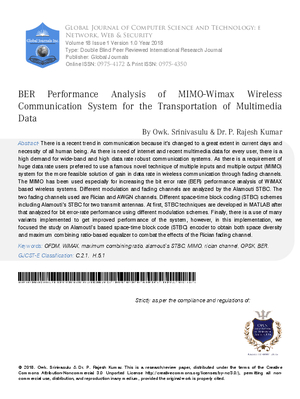Abstract
There is a recent trend in communication because it s changed to a great extent in current days and necessity of all human being As there is need of internet and recent multimedia data for every user there is a high demand for wide-band and high data rate robust communication systems As there is a requirement of huge data rate users preferred to use a famous novel technique of multiple inputs and multiple output MIMO system for the more feasible solution of gain in data rate in wireless communication through fading channels The MIMO has been used especially for increasing the bit error rate BER performance analysis of WiMAX based wireless systems Different modulation and fading channels are analyzed by the Alamouti STBC The two fading channels used are Rician and AWGN channels Different space-time block coding STBC schemes including Alamouti s STBC for two transmit antennas At first STBC techniques are developed in MATLAB after that analyzed for bit error-rate performance using different modulation schemes Finally there is a use of many variants implemented to get improved performance of the system however in this implementation we focused the study on Alamouti s based space-time block code STBC encoder to obtain both space diversity and maximum combining ratio-based equalizer to combat the effects of the Rician fading channel Different modulation schemes are used to get the high data rates of Wi-MAX is QPSK We calculated BER performance of proposed work for different SNRS and represent the results for different cases of multimedia data
This work is licensed under a Creative Commons Attribution 4.0 International License.
Copyright (c) 2018 Authors and Global Journals Private Limited

